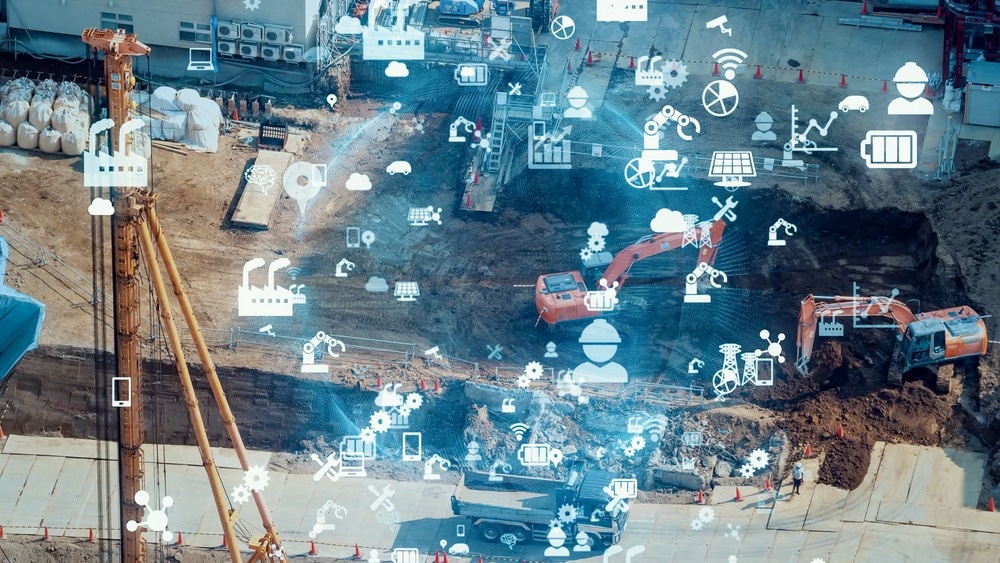The use of artificial intelligence (AI) in the construction industry holds significant promise to deliver value across project lifecycles. With broad applications encompassing design, bidding, financing, procurement, operations, asset management, and business model transformation, AI is poised to revolutionize the industry. Potential benefits include mitigating cost overruns, enhancing site safety, streamlining project plan management, and driving productivity growth on worksites.

Image Credit: Gorodenkoff/Shutterstock.com
Can AI Solve Construction’s Productivity Problem
It is projected that the global construction market will experience an 85% growth, reaching USD 15.5 trillion by 2030. AI could potentially increase productivity from 0.8% to 1.4% annually.
The industry has traditionally exhibited low levels of innovation, resulting in limited global productivity and growth. This is particularly evident in its comparatively low level of digitization, which lags behind that of other industries, including manufacturing, warehousing and logistics, consumer retail, and telecommunications.
Despite a minimal annual productivity growth of approximately 1% over the last two decades, the adoption of innovative tools like AI presents a significant opportunity to improve efficiency and productivity within the construction industry.
The industry is starting to take note of this potential. Considerable resources have been allocated towards research and development (R&D) initiatives aimed at advancing AI technologies within the construction industry. In the period spanning 2014 to 2019, the global construction sector expended USD 26 billion on engineering and construction technologies, which included AI, representing a significant increase from the USD 8 billion invested over the preceding five years.
Below are examples of how the construction industry can adopt and is adopting AI technologies to improve workflows.
BIM
Building Information Modeling (BIM) has emerged as a foundational digital framework for the construction industry. When combined with AI, BIM has the potential to create new value by enhancing the management of complex and unpredictable construction projects. By leveraging AI, BIM procedures can be streamlined and automated, including automated design and rule checking, 3D as-built reconstruction, event log mining, building performance analysis, virtual and augmented reality, and digital twinning.
Big Data
The detection and assessment of risks in the construction industry can be enhanced with AI to predict incidents and issue early warnings. With smart wearables, valuable data can be collected and analyzed for the development of AI algorithms designed to address potential issues on-site and implement new strategies aimed at enhancing overall efficiency. Furthermore, the insights gleaned from data analytics can be utilized for strategic decision-making purposes, further bolstering risk management efforts in the industry.
Waste and Resources
Construction firms are placing more emphasis on waste reduction and adopting proactive data-driven approaches that leverage advanced analytics with AI to minimize waste. AI transforms raw data into actionable insights. Strategies include optimizing offsite construction, selecting appropriate materials, implementing waste-efficient procurement practices, facilitating reuse and recovery efforts, deconstruction, and promoting flexibility in construction processes.

Image Credit: metamorworks/Shutterstock.com
Planning and Scheduling
AI models are a valuable tool for predicting construction costs and project timelines accurately. The repercussions of inaccurate cost and time estimations are financially significant. Additionally, AI technologies like deep learning, which emulates the human brain by utilizing predictive modeling and statistics, can further enhance the precision of time and cost forecasting in construction projects.
Health and Safety
Advanced analytics can enhance workplace safety by utilizing predictive analytics in the construction industry. Due to the high number of injuries recorded in this industry, companies need to take a proactive approach to prevent accidents caused by onsite dangers such as falling objects, equipment, tools, toxic materials, and heights. AI and BIM technologies can reduce the risk of accidents and improve safety through sensor-based and wearable safety monitoring technologies. These tools can identify potential dangers on a construction site and alert managers in advance to mitigate risks.
Job Creation
The risk of redundancy in construction jobs that require low to medium education is increasing. By 2030, 38-45% of these jobs are expected to be completed by automated analytics or robotics. Nevertheless, the implementation of AI can also bring new job opportunities, including construction AI researchers, trainers, and engineers, who can retrain and assimilate displaced workers in the industry.
Challenges to Widespread Adoption in Construction
A recent study by Queensland University of Technology (Australia) and Hong Kong Shue Yan University (China) researchers published in the Journal of Open Innovation examined the adoption challenges of AI in the construction industry, along with the opportunities offered.
The study yielded three key findings. Firstly, AI offers particular benefits in the planning stage by providing accurate forecasting of events, risks, and costs, which are critical to the success of construction projects. Secondly, the adoption of AI presents significant opportunities to reduce the time spent on repetitive tasks by leveraging big data analytics and optimizing work processes. Thirdly, the fragmented nature of the construction industry presents the biggest challenge to incorporating AI on a construction site, with issues related to data acquisition and retention.
The major obstacles to the widespread adoption of AI in the construction industry include cultural factors, security concerns, high upfront costs, project uniqueness, robotic technologies, institutional barriers, and information sharing.
These challenges are common to relatively immature technologies, and as more construction companies begin to adopt AI, there will be a cascading effect that reduces their impact. As other industries continue to embrace AI for productivity gains, construction will surely follow.
More from AZoBuild - Smart Houses: AI in the Home
References and Further Reading
Pan, Y., and L. Zhang (2023). Integrating BIM and AI for Smart Construction Management: Current Status and Future Directions. Archives of Computational Methods in Engineering. doi.org/10.1007/s11831-022-09830-8.
Rao, S. (2022). The Benefits of AI In Construction. [Online] Trimble Construction. Available at: https://constructible.trimble.com/construction-industry/the-benefits-of-ai-in-construction (Accessed on 9 March 2023).
Regona, M., et al (2022). Opportunities and Adoption Challenges of AI in the Construction Industry: A PRISMA Review. Journal of Open Innovation: Technology, Market, and Complexity. doi.org/10.3390/joitmc8010045.
Disclaimer: The views expressed here are those of the author expressed in their private capacity and do not necessarily represent the views of AZoM.com Limited T/A AZoNetwork the owner and operator of this website. This disclaimer forms part of the Terms and conditions of use of this website.